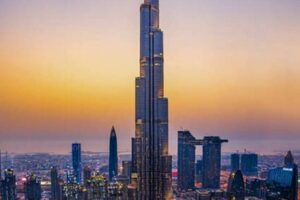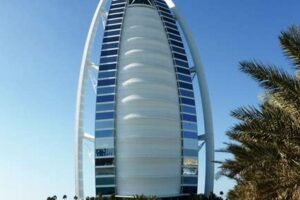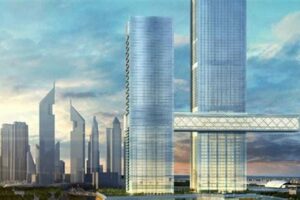Burj Khalifa, known colloquially as the Burj Dubai, is a skyscraper in Dubai, United Arab Emirates. With a total height of 828 meters (2,717 feet), and a roof height of 828 meters (2,717 feet), the Burj Khalifa has been the tallest structure and building in the world since its topping out in 2009, surpassing the KVLY-TV mast in Blanchard, North Dakota.
Designed by Adrian Smith of Skidmore, Owings & Merrill, the Burj Khalifa was developed by Emaar Properties, and primarily financed by Abu Dhabi’s government and corporate entities. Construction began on 21 September 2004, with the exterior completed on 1 October 2009. The building was officially opened on 4 January 2010, and named in honor of the UAE President Khalifa bin Zayed Al Nahyan. A mixed-use skyscraper, the Burj Khalifa contains 163 floors, with residential apartments, hotel rooms, and corporate offices. The building also has several observation decks, including the At the Top observation deck on the 124th floor, which is the highest observation deck in the world.
The Burj Khalifa has been a popular tourist destination since its opening, and has been featured in numerous films and television shows. The building has also been the site of several world records, including the highest base jump from a building, and the highest fireworks display.
1. Height
The height of the Burj Khalifa, standing at an astounding 828 meters (2,717 feet), is a defining characteristic that sets it apart as the world’s tallest skyscraper. This exceptional height is not merely a record-breaking feat but also a testament to the remarkable engineering and architectural prowess behind its construction.
The building’s height is achieved through a combination of innovative design and cutting-edge construction techniques. The Burj Khalifa’s structural core, made of reinforced concrete, provides exceptional stability and strength, allowing it to withstand high winds and seismic activity. Additionally, the use of high-performance concrete and advanced construction methods, such as slip-forming, enabled the efficient and rapid construction of the building’s towering height.
The practical significance of the Burj Khalifa’s height is multifaceted. Its sheer size and visibility make it an iconic landmark, symbolizing Dubai’s rapid development and economic growth. The building’s height also offers practical benefits, including panoramic views from its observation decks, which attract tourists worldwide. Furthermore, the high floors of the Burj Khalifa house luxury apartments and corporate offices, providing occupants with breathtaking vistas and a prestigious address.
2. Floors
The Burj Khalifa’s 163 floors are a defining characteristic that contributes to its exceptional height and multi-purpose functionality. The sheer number of floors allows for a diverse range of uses, accommodating a vast array of occupants and activities within a single structure.
The lower floors of the Burj Khalifa house a bustling retail mall, featuring an array of luxury boutiques, restaurants, and entertainment venues. As one ascends the building, the floors transition into residential apartments, offering occupants stunning views of the city and beyond. The higher floors are dedicated to corporate offices, providing businesses with prestigious and convenient workspaces amidst the iconic skyscraper.
The practical significance of the Burj Khalifa’s 163 floors is multifaceted. The building’s height and floor count make it a vertical city, accommodating a diverse population of residents, workers, and visitors within its confines. This concentration of activity contributes to the vibrant and dynamic atmosphere of the surrounding area, fostering economic growth and development.
Furthermore, the efficient use of space within the Burj Khalifa’s 163 floors showcases innovative architectural planning and design. The building’s core structure and efficient floor plan maximize usable space, allowing for a multitude of functions and amenities to coexist harmoniously. This thoughtful design ensures that the Burj Khalifa remains a marvel of modern architecture and a symbol of Dubai’s forward-thinking approach to urban development.
3. Use
The Burj Khalifa’s mixed-use design, encompassing residential, hotel, and corporate functions, is a key aspect that sets it apart from other skyscrapers and contributes to its unique character and functionality.
- Vertical City: The Burj Khalifa’s diverse uses create a vertical city within a single structure, fostering a vibrant and dynamic environment. Residents, hotel guests, and corporate employees coexist within the building, creating a microcosm of urban life.
- Convenience and Efficiency: The mixed-use design offers unparalleled convenience and efficiency for occupants. Residents can enjoy the amenities of the retail mall and access their offices within the same building, eliminating the need for long commutes. Corporate tenants benefit from the proximity to residential and hospitality services, enhancing employee satisfaction and productivity.
- Economic Impact: The Burj Khalifa’s mixed-use nature stimulates economic growth and development in the surrounding area. The retail mall attracts visitors and generates revenue, while the presence of corporate offices creates job opportunities and supports local businesses.
- Architectural Innovation: The mixed-use design posed unique architectural challenges, requiring innovative solutions to ensure the efficient integration of different functions. The Burj Khalifa’s structural design and floor plan were meticulously planned to accommodate the diverse needs of its occupants, showcasing the building’s architectural ingenuity.
In conclusion, the Burj Khalifa’s mixed-use design is not merely a functional choice but a strategic move that enhances the building’s functionality, fosters a vibrant community, stimulates economic growth, and showcases architectural innovation. It is a testament to the forward-thinking vision of Dubai and its commitment to creating iconic and sustainable urban landmarks.
4. Architect
Adrian Smith, the lead architect of Skidmore, Owings & Merrill (SOM), played a pivotal role in the design and construction of the Burj Khalifa, leaving an indelible mark on the architectural landscape of Dubai.
- Visionary Design: Smith’s visionary design for the Burj Khalifa pushed the boundaries of architectural possibility, creating a structure that defied conventional wisdom and set a new benchmark for supertall skyscrapers.
- Structural Ingenuity: Smith’s deep understanding of structural engineering enabled him to develop innovative solutions for the Burj Khalifa’s unique challenges, including its exceptional height and wind resistance.
- Sustainability Focus: Smith incorporated sustainable design principles into the Burj Khalifa, making it one of the most environmentally conscious skyscrapers in the world.
- Global Recognition: Smith’s work on the Burj Khalifa garnered international acclaim and recognition, solidifying his reputation as one of the world’s leading architects.
Adrian Smith’s contributions to the Burj Khalifa showcase his exceptional architectural prowess and commitment to pushing the limits of design and engineering. His vision and expertise were instrumental in creating an iconic landmark that continues to inspire and captivate the world.
5. Developer
Emaar Properties, a renowned real estate developer based in Dubai, played a pivotal role in the development and construction of the Burj Khalifa, the world’s tallest skyscraper. Their involvement was crucial in bringing this architectural marvel to life.
Emaar Properties, led by its visionary Chairman Mohamed Alabbar, had the foresight to recognize the potential of the Burj Khalifa as a global icon. They assembled a team of world-class architects, engineers, and contractors to execute this ambitious project.
Emaar Properties’ commitment to excellence and innovation was evident throughout the construction process. They employed cutting-edge technologies and sustainable practices to ensure the Burj Khalifa’s structural integrity and environmental consciousness.
The successful completion of the Burj Khalifa not only established Emaar Properties as a leading real estate developer but also solidified Dubai’s position as a global hub for architectural innovation and engineering prowess.
6. Location
The location of the Burj Khalifa in Dubai, United Arab Emirates, is not merely a coincidence but a strategic choice that has played a crucial role in its success and significance.
Dubai’s rapid economic growth and ambitious development plans created an ideal environment for the construction of a supertall skyscraper like the Burj Khalifa. The city’s commitment to innovation and its position as a global business hub attracted the necessary investment and expertise for this ambitious project.
Moreover, Dubai’s geographic location at the crossroads of major trade routes and its proximity to emerging markets made the Burj Khalifa a symbol of the city’s global aspirations. Its presence has transformed Dubai into a destination for tourists, businesses, and investors worldwide.
Furthermore, the Burj Khalifa’s location within Dubai has practical implications for its functionality and accessibility. Its proximity to major transportation hubs, including the Dubai International Airport and the Dubai Metro, ensures convenient access for visitors and occupants.
In conclusion, the location of the Burj Khalifa in Dubai, United Arab Emirates, is not just a geographic coincidence but a carefully considered decision that has shaped its identity, significance, and practical functionality as the world’s tallest skyscraper.
7. Construction
The construction of the Burj Khalifa, spanning from 2004 to 2010, was a monumental undertaking that involved meticulous planning, cutting-edge engineering, and the collaboration of thousands of workers.
- Architectural Innovation: The Burj Khalifa pushed the boundaries of architectural design, incorporating innovative features such as its Y-shaped floor plan and buttressed core structure. These advancements allowed for the building’s exceptional height and stability.
- Engineering Marvels: The construction process employed advanced engineering techniques, including the use of high-performance concrete and slip-forming construction methods. These techniques enabled the rapid and efficient construction of the skyscraper’s massive structure.
- Global Collaboration: The Burj Khalifa’s construction involved a global team of architects, engineers, and construction workers from various countries. This collaboration fostered knowledge sharing and the exchange of expertise, ensuring the successful completion of the project.
- Economic Impact: The construction of the Burj Khalifa had a significant economic impact on Dubai and the United Arab Emirates. It created thousands of jobs, stimulated the growth of related industries, and contributed to the city’s reputation as a global hub for innovation and development.
The construction of the Burj Khalifa stands as a testament to human ingenuity and the pursuit of architectural excellence. It not only resulted in the world’s tallest building but also showcased the transformative power of construction in shaping skylines and driving economic progress.
8. Cost
The construction of the Burj Khalifa, an architectural marvel and a symbol of Dubai’s economic growth, came with a substantial price tag. The estimated cost of $1.5 billion reflects the immense scale, complexity, and innovative nature of the project.
This significant investment was crucial in realizing the Burj Khalifa’s ambitious design and engineering. The use of high-performance materials, advanced construction techniques, and a global team of experts required substantial financial resources. The cost was not merely a monetary figure but an investment in pushing the boundaries of architectural possibility and creating an iconic landmark.
Understanding the cost of the Burj Khalifa provides insights into the economic impact of such large-scale construction projects. It highlights the importance of financial resources in shaping architectural achievements and the role of investment in driving innovation. Furthermore, it underscores the economic significance of iconic structures in attracting tourism, enhancing a city’s global profile, and stimulating related industries.
9. Records
The Burj Khalifa holds two significant records: being the tallest building and having the highest observation deck in the world. These records are not just accolades but are integral to the identity and significance of the Burj Khalifa.
The height of the Burj Khalifa, standing at an impressive 828 meters (2,717 feet), is a testament to the advancements in architecture and engineering. Its towering presence has redefined the skyline of Dubai and has made it an iconic landmark recognized globally.
Complementing its height, the Burj Khalifa also boasts the highest observation deck in the world, At the Top, located on the 124th floor. This observation deck offers breathtaking panoramic views of Dubai and its surroundings, attracting tourists from around the world. The experience of visiting At the Top is not just about admiring the views but also about witnessing the architectural marvel up close.
The records held by the Burj Khalifa have practical implications as well. The building’s height allows for efficient use of vertical space, accommodating various functions such as residential, commercial, and hospitality within a single structure. The observation deck, on the other hand, serves as a major tourist attraction, contributing to Dubai’s economy and enhancing its global visibility.
In conclusion, the records of being the tallest building and having the highest observation deck are not just accolades for the Burj Khalifa but are key components that define its identity, showcase architectural prowess, and contribute to its practical and economic significance.
Frequently Asked Questions about Dubai Skyscraper Burj
This section addresses common queries and misconceptions surrounding the iconic Burj Khalifa, providing informative and concise answers.
Question 1: What is the height of the Burj Khalifa?
Answer: The Burj Khalifa stands at an impressive 828 meters (2,717 feet), making it the tallest building in the world.
Question 2: How many floors does the Burj Khalifa have?
Answer: The Burj Khalifa has 163 floors, accommodating a diverse range of uses, including residential apartments, hotel rooms, and corporate offices.
Question 3: Who was the architect behind the Burj Khalifa?
Answer: The Burj Khalifa was designed by Adrian Smith of Skidmore, Owings & Merrill (SOM), a renowned architectural firm known for its innovative and sustainable designs.
Question 4: How long did it take to construct the Burj Khalifa?
Answer: The construction of the Burj Khalifa spanned from 2004 to 2010, involving meticulous planning, cutting-edge engineering, and the collaboration of thousands of workers.
Question 5: How much did it cost to build the Burj Khalifa?
Answer: The estimated cost of constructing the Burj Khalifa was approximately $1.5 billion, reflecting the scale, complexity, and innovative nature of the project.
Question 6: What are the unique features of the Burj Khalifa?
Answer: The Burj Khalifa holds two significant records: it is the tallest building in the world and has the highest observation deck, offering breathtaking panoramic views of Dubai.
In conclusion, the Burj Khalifa stands as a testament to human ingenuity, architectural innovation, and engineering prowess. Its iconic status and record-breaking height continue to captivate and inspire people worldwide.
Transition to the next article section: Exploring the Architectural Marvels of Dubai
Valuable Tips Regarding Dubai Skyscraper Burj
The Burj Khalifa, an architectural marvel and a symbol of Dubai’s economic growth, offers visitors and enthusiasts alike a range of experiences and opportunities. Here are some valuable tips to enhance your exploration of this iconic skyscraper:
Tip 1: Advance Planning and Ticket Purchase: To avoid queues and secure your spot, book your tickets for the Burj Khalifa’s observation deck, At the Top, in advance. Consider purchasing a ticket that includes access to higher floors for a more exclusive experience.
Tip 2: Choose the Right Time: Visit the Burj Khalifa during off-peak hours or weekdays to avoid crowds and enjoy a more serene experience. If you seek stunning sunset or nighttime views, plan your visit accordingly.
Tip 3: Utilize Guided Tours: Enhance your visit with a guided tour led by knowledgeable experts. These tours provide insights into the architectural marvels and engineering feats that went into creating the Burj Khalifa.
Tip 4: Explore the Surroundings: Take time to explore the vibrant area surrounding the Burj Khalifa, including the Dubai Mall, the Dubai Fountain, and Souk Al Bahar. This will provide a well-rounded experience of Dubai’s modern marvels and cultural heritage.
Tip 5: Respect the Dress Code: Observe the Burj Khalifa’s dress code, which requires modest and respectful attire. Avoid wearing shorts, tank tops, or other casual clothing to maintain the building’s sophisticated ambiance.
Summary: By following these tips, you can maximize your experience at the Burj Khalifa, gaining valuable insights, capturing breathtaking moments, and creating lasting memories of this architectural icon.
Transition to the article’s conclusion: Concluding Remarks and Lasting Impressions
Conclusion
The Burj Khalifa, an architectural marvel and a symbol of Dubai’s economic growth, stands as a testament to human ingenuity, engineering prowess, and the pursuit of architectural excellence. Its record-breaking height, innovative design, and luxurious amenities have made it an iconic landmark, attracting visitors from around the world.
Through its observation decks, visitors can experience breathtaking views of Dubai’s skyline, while the surrounding area offers a vibrant mix of shopping, dining, and entertainment options. The Burj Khalifa’s significance extends beyond its physical presence, as it has become a symbol of Dubai’s ambitions and its commitment to pushing the boundaries of possibility.
As a beacon of innovation and architectural achievement, the Burj Khalifa continues to inspire and captivate, solidifying its place as one of the world’s most iconic and recognizable structures. Its legacy will endure, serving as a reminder of the power of human ambition and the endless possibilities of architectural design.







